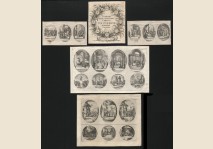Shopping Options
- Specification
-
- Print (1)
- technic
-
- Etching (1)
- period
-
- 17th century (1)
- School
-
- French (1)
- subject
-
- Religious (1)
- rating
-
- ***** (1)
- new
-
- yes (1)
- Artist
-
- Jacques Callot (1)
Jacques Callot (1592-1632)
Jacques Callot (1592-1632) was one of the earliest great creative artists to practice the graphic arts exclusively. His career can be divided into two periods: an Italian period, c. 1609-1621, and a Lorraine period from 1621 until his death. Callot studied the technique of engraving under Phillipe Thomasin in Rome. About 1612 he joined Guilio Parigi in Florence. At that time Medici patronage expended itself almost exclusively on "feste," and both Parigi and Callot were employed by Cosimo II (de Medici) to create visual records of these entertainments. Callots compositions are organized as if they were a stage setting and reduced the figures to a tiny scale, each one being rendered by the fewest possible strokes. This required an extremely fine etching technique. Callot enjoyed a lasting popularity all over Europe. He returned to Nancy after Cosimo*s death in 1621. During the Lorraine period Callot illustrated sacred books, made a series of plates of the Apostles, and visited Paris to make animated maps of the sieges of La Rochelle and the Ile de RÈ. Callot was one of the first etchers to used the technique of repeated biting, and sometimes combined graver work with etching








 Facebook
Facebook Twitter
Twitter Subscribe us
Subscribe us Flickr
Flickr




